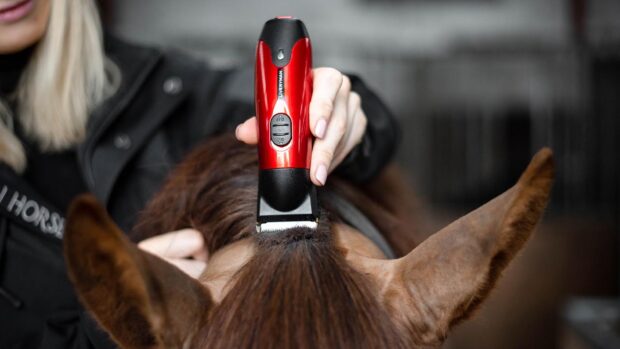That show is coming up, you want your horse immaculately turned out, but do you shave his whiskers? It’s a divisive subject. On one hand, the whiskers — also called vibrissae — arguably serve essential sensory functions, while on the other hand, a horse with no excess hair on his face is deemed aesthetically pleasing.
In 1998, Germany outlawed whisker shaving. Paragraph six of the German Animal Welfare Law prohibits trimming the vibrissae around eyes and muzzle, as well as clipping or cutting the hairs inside the ears. Practically, this means a competitor with a shaved horse can be disqualified from a show.
It remains legal in Britain, although the BHS and many British riders find it troubling.
Gemma Stanford, the BHS Director of Welfare, told H&H: “The purpose of the horse’s whiskers both around the eyes and muzzle provide sensory feedback on the horse’s environment. The length of the whiskers determines the safe distance from unfamiliar objects or substances and enables them to determine unfamiliar characteristics of food or detect small inedible objects providing an environmental map.
“The whiskers present on both upper and lower eyelids provide tactile stimulation and elicit the blink response. Due to the whiskers having a good nerve supply they are even thought to be capable of picking up vibrational energy (sound).”
Rachel Jordan lives in Gloucestershire, competing two horses in showing and dressage. She reflects: “I do think it makes their everyday lives more comfortable to keep [whiskers].”
When she started showing her older horse, she was encouraged to remove her whiskers but refused, explaining: “If a judge wanted to give her a lower placing because she had whiskers, that just reflects poorly on the showing scene in my opinion. It’s only by standing against these old ‘norms’ that you can change them.”
Professional groom Hollie Haynes worked on a thoroughbred preparation yard for 11 years and is now freelance. Her boss used to shave whiskers, because he thought the young thoroughbreds sold for more money, but, she says: “Horses need them for feeling in the dark and sensing how close items are to their muzzle. I have seen horses bang their heads after having them removed because they don’t realise they no longer have them.”
While there’s anecdotal evidence suggesting horses with trimmed vibrissae are more prone to facial injuries, there is no direct scientific proof of how, and to what degree, vibrissae inform horses about their environment.
According to Dutch veterinarian Machteld Van Dierendonck, studies of vibrissae had been conducted on rodents and sea mammals, with the results applied to horses, but none had actually looked at horses. So she ran a pilot study examining the function of equine whiskers and the effect of shaving them. She had no definitive results and speculated that it could be due to a number of factors: a small sample size, methods that didn’t work, or equine whiskers not being as vital as scientists thought.
People who shave whiskers argue they haven’t noticed any adverse effects. Yard manager Laura White says: “I shave of all my horses’ whiskers and have done for over 15 years. I’ve never had a horse that has a problem with it. I shave them off because I think they look smarter without them, but it’s personal preference.”
Continued below…

15 impressively artistic clips to leave mere mortals stunned
Some people have an amazing talent in 'clip art'. Here's just a few that will make you look twice and
It’s not an all-or-nothing thing, either. Jessica Moore, a groom for international showjumpers, remarks: “One of my FEI horses would grow what appeared to be a handlebar moustache if he went much more than a week between trims. I also believe the purpose of the guard hairs on the muzzle aren’t of much use to domestic horses who live in extremely controlled environments like stalls and small to medium paddocks.”
But she doesn’t clip the vibrissae near the eyes, reasoning: “I do believe the guard hairs around the eyes are important and absolutely do help protect horses from the random eye injuries that can happen even in the box.”
For all the latest news analysis, competition reports, interviews, features and much more, don’t miss Horse & Hound magazine, on sale every Thursday



